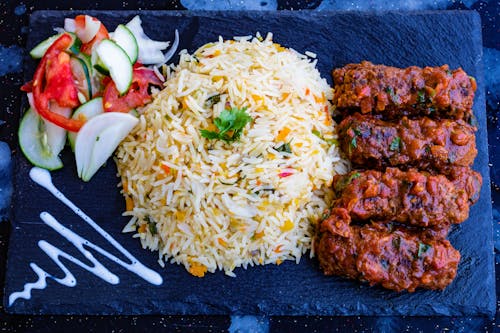
India, a country with the richest diversity, hundreds of languages, thousands of traditions, and millions of people, can all be connected with just one thing – food. Imagine a steaming pot of biryani with its aroma and each golden grain of rice begging to be scooped up, not with a silver spoon, but with the warmth of your fingertips. The little picture you painted depicts the rich tradition of eating with bare hands is much more than a cultural practice.
While utensils have become the norm in many parts of the world, India's culinary heritage proudly embraces the hands as not just tools but extensions of the palate itself. According to a study published in the International Journal of Gastronomy and Food Science in 2022, eating with hands activates acupressure points on the fingertips, potentially stimulating the digestive system and enhancing nutrient absorption. This mind-body link between touch and digestion resonates deeply with Ayurveda, India's ancient holistic healing system, emphasising the connection between body and mind.
Why don’t you read ahead and dive deeper into the science of eating with bare hands?
The Art of Eating with Bare Hands
For many people in the Western world, ditching their forks and knives and eating with their hands might seem unhygienic or messy. However, as you might already know, it is still a common practice. Fortunately, thanks to Ayurveda and research, the benefits of eating with their hands are resurfacing, and people are starting to get back the advantageous cultures and traditions of the past.
Connecting with the Senses

When you eat with your hands, you engage multiple senses simultaneously—touch, taste, sight, and even smell. The warmth of the food transfers directly to the fingertips, sending signals to the brain that enhance flavour perception. The texture of rice grains or the pillowy softness of roti (flatbread) becomes a textural adventure, adding another dimension to the taste. Thus, the multisensory experience can heighten awareness and appreciation for each bite, promoting mindful eating and preventing overeating.
Taking The Ayurvedic Perspective Into Account
Ayurveda, the ancient Indian system of medicine, emphasises the importance of maintaining balance within the body and mind. According to another study published in the Journal of Ethnic Foods in 2018, Ayurvedic principles say that each finger is associated with one of the five elements—thumb with fire, index finger with air, middle finger with ether, ring finger with earth, and little finger with water. When you eat with your hands, your fingertips come into contact with the food, facilitating the transfer of these elemental energies.

Improved Digestion
The process of eating with hands begins long before food reaches the mouth. It starts with the act of touching and picking up food, which triggers the release of saliva and digestive enzymes in anticipation of the meal. This pre-digestive phase primes the digestive system, making it more efficient in breaking down food and absorbing nutrients.
Mindful Eating
In today's fast-paced world, where meals are often rushed affairs squeezed between meetings and appointments, eating with hands encourages mindfulness. It compels you to slow down, savour each bite, and be fully present in the moment. Thus, the mindful approach to eating enhances the enjoyment of food and fosters a deeper appreciation for the culinary experience.
Social and Cultural Significance
In Indian culture, food is much more than a necessity for survival; it's a social glue that binds families and communities together. Eating with hands is deeply ingrained in the fabric of Indian society, serving as a symbol of hospitality, intimacy, and togetherness. Whether it's sharing a meal with loved ones at home or participating in a communal feast during festivals, eating with hands fosters a sense of unity and connection.

Beyond Tradition: A Modern Take
While eating with hands might seem unconventional to some, it's important to remember that it's not merely a practice of the past. Many Indians, especially in rural areas, continue to embrace this tradition, and even in urban settings, it's not uncommon to see families enjoying a meal together in this way. Additionally, the growing interest in mindful eating and gut health has led to a renewed appreciation for the potential benefits of this practice.



